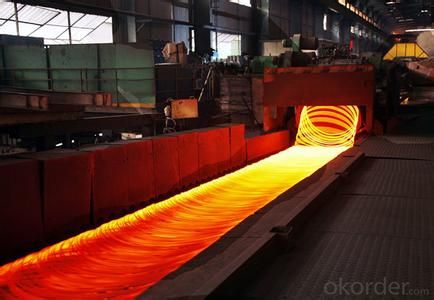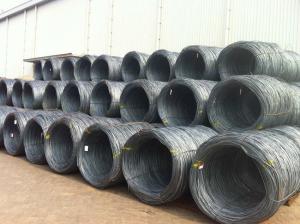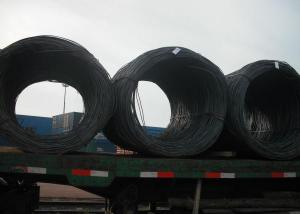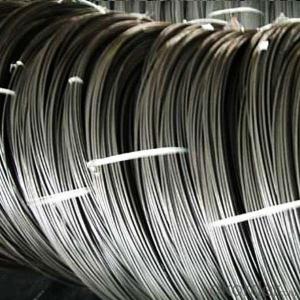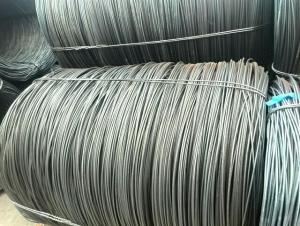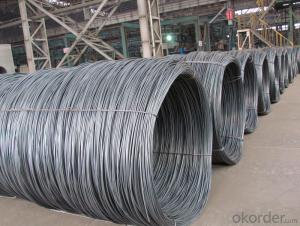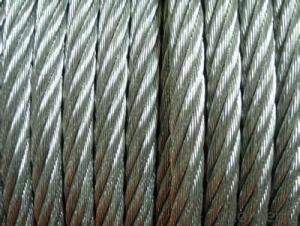Q195 Steel Wire Rod
- Loading Port:
- China Main Port
- Payment Terms:
- TT OR LC
- Min Order Qty:
- -
- Supply Capability:
- -
OKorder Service Pledge
OKorder Financial Service
You Might Also Like
Specifications of Wire Rod Q195:
Grade: Q195 Standard: GB
Diameter: 5.5mm, 6.5mm, 7mm, 8mm
Alloy or Not: Alloy
Technique: Hot Rolled Place of Origin: China Mainland
Chemical Composition:
Please kindly find our chemistry of our material based on Q195 as below for your reference:
Trademark | Rank | Chemical composition (quality score) % | | ||||
C | Si | Mn | S | P | | ||
| | |||||||
| ≤ |
| ≤ | ≤ | | ||
Q195 |
| 0.06-0.12 | 0.30 | 0.25 | 0.050 | 0.045 | |
Trademark | Rank | Pulling Test | | ||||
Bend PointΔs/Mpa | Tensile Strength | Elongation Ratioδ5% | | ||||
| | |||||||
Thickness (Diameter) /MM | Thickness (Diameter) /MM | | |||||
≤16 | 16-40 | | ≤16 | 16-40 | | ||
≥ | | ≥ | | ||||
Q195 |
| 195 | 185 | 315-390 | 33 | 32 | |
Usage and Applications of Wire Rod Q195:
After hot-rolled the products shaped into coil and delivery as finished product, including round, square,rectangular, hexagonal and so on. Since most of the products are round, it is generally called wire rod. Carbon steel wire rod is widely used in construction and manufacturing. Carbon steel wire rod is mainly used for reinforcement of reinforced concrete and welded structure or reprocessed (roberts , nail, etc.) materials, especially used to produce wire drawing, welding electrode, nails, spring, electronic, precise machinery parts and so on.
Packaging & Delivery of Wire Rod Q195:
Packaging Detail: products are packed in coil and then shipped by container or bulk vessel
Each coil weight: About 2.05MT
Delivery Detail: within 45 days after received deposit or LC.
Label: to be specified by customer, generally, each bundle has 1-2 labels
Trade terms: FOB, CFR, CIF
*If you would like to get our price, please inform us the size, standard/material and quantity. Thank you very much for your attention.
- Q: What are the different types of steel wire rod surface defect classification and grading systems?
- There are several different types of steel wire rod surface defect classification and grading systems, including the ASTM (American Society for Testing and Materials) system, the ISO (International Organization for Standardization) system, and the JIS (Japanese Industrial Standards) system. These systems categorize surface defects based on their type, size, and severity, allowing for a standardized method of assessing and grading the quality of steel wire rods.
- Q: How is steel wire rod used in the manufacturing of wire for suspension systems in planes?
- Steel wire rod is an essential component in the manufacturing of wire for suspension systems in planes. It is used to create high-strength wires that provide support and stability to the suspension systems. The steel wire rod undergoes a series of processes, such as drawing and annealing, to enhance its strength and flexibility. These wires are then used to construct various suspension components, including springs and shock absorbers, which play a critical role in ensuring smooth and safe flight operations.
- Q: What are the common industry conferences for steel wire rod?
- Some common industry conferences for steel wire rod include the International Wire & Cable Symposium (IWCS), the Wire & Cable Conference (W&C), and the Steel Wire Rod Conference (SWRC). These conferences provide a platform for professionals, manufacturers, and researchers in the steel wire rod industry to network, exchange knowledge, and discuss the latest advancements in technology and industry trends.
- Q: What are the main factors influencing the choice of steel wire rod order payment method?
- The main factors influencing the choice of steel wire rod order payment method include the buyer's financial position and creditworthiness, the seller's trust in the buyer, the volume and frequency of orders, market conditions, and the overall relationship between the buyer and seller.
- Q: How is steel wire rod used in the manufacturing of wire forms for marine equipment?
- Steel wire rod is essential for producing wire forms used in marine equipment. Its exceptional strength, durability, and resistance to corrosion make it an integral component. The wire rod is the raw material that undergoes various manufacturing processes to create different wire forms for marine equipment. To begin, a careful selection process is carried out to choose steel wire rod based on its composition, quality, and mechanical properties. High tensile strength and corrosion resistance are crucial for withstanding the harsh saltwater environments that marine equipment is exposed to. Once the suitable steel wire rod is obtained, it undergoes a series of manufacturing processes. These processes include drawing, annealing, and coating. Drawing involves reducing the diameter of the wire rod by pulling it through progressively smaller dies to achieve the desired thickness. Annealing is performed to enhance the wire's ductility and relieve any stresses. Coating is often applied to further improve the wire forms' resistance to corrosion. The wire forms made from steel wire rod are widely used in marine equipment. They can be fabricated into various shapes and sizes, such as hooks, loops, springs, and clips. Common applications include fishing nets, boat rigging, anchor cables, and mooring lines. The strength and durability of steel wire rod ensure that the wire forms can withstand the challenging conditions of the marine environment, including heavy loads, constant saltwater exposure, and extreme weather. Moreover, the corrosion resistance properties of the wire forms contribute to their long lifespan, reducing the need for frequent replacements and maintenance. In conclusion, steel wire rod is crucial for manufacturing wire forms used in marine equipment. It provides the necessary strength, durability, and corrosion resistance to withstand the demanding conditions encountered at sea.
- Q: How is steel wire rod tested for uniformity of diameter?
- Steel wire rod is tested for uniformity of diameter through a process called diameter measurement. This involves using high-precision instruments, such as micrometers or laser gauges, to measure the diameter at various points along the rod. These measurements are then compared to establish the degree of uniformity. Additionally, statistical analysis may be performed to determine the average diameter and the range of variation within the wire rod.
- Q: What are the common production processes for galvanized steel wire rod?
- The common production processes for galvanized steel wire rod include wire drawing, heat treatment, galvanization, and coiling.
- Q: What are the different types of steel wire rod rolling mills?
- There are several different types of steel wire rod rolling mills that are used in the steel manufacturing industry. These mills are designed to produce wire rods with specific dimensions and characteristics, depending on the requirements of the end-use applications. Some of the common types of steel wire rod rolling mills include: 1. Two-high rolling mills: These mills have two rolls that are used to reduce the thickness of the wire rod. The rolls rotate in opposite directions, pulling the wire rod through the mill and reducing its diameter in the process. Two-high rolling mills are typically used for roughing and intermediate rolling stages. 2. Three-high rolling mills: These mills have three rolls, with one roll placed on top of the other two. The wire rod passes through the gap between the rolls and is reduced in thickness and diameter. Three-high rolling mills are often used for finishing and precision rolling stages. 3. Four-high rolling mills: These mills have four rolls, with two rolls placed on top of the other two. The wire rod passes through the gap between the rolls in a zigzag pattern, allowing for higher reduction ratios and improved dimensional accuracy. Four-high rolling mills are commonly used for high-speed rolling operations. 4. Tandem rolling mills: These mills consist of a series of rolling stands arranged in tandem, with each stand performing a specific reduction operation. The wire rod passes through each stand sequentially, undergoing multiple reductions to achieve the desired dimensions and surface finish. Tandem rolling mills are used for high-volume production of wire rods. 5. Continuous rolling mills: These mills are designed for continuous operation, with the wire rod being continuously fed into the mill and the finished product being continuously discharged. Continuous rolling mills are highly efficient and are used for high-speed production of wire rods. In addition to these types, there are also specialized rolling mills that are designed for specific applications, such as planetary rolling mills, which are used for rolling thin-walled wire rods, and reversible rolling mills, which can change the direction of rolling to achieve different properties in the wire rod. The choice of the appropriate type of rolling mill depends on factors such as the desired dimensions, surface finish, and mechanical properties of the wire rod.
- Q: Can steel wire rod be used for reinforcement purposes?
- Yes, steel wire rod can be used for reinforcement purposes. Steel wire rod is often used to reinforce concrete structures such as buildings, bridges, and highways. This is because steel has high tensile strength and can withstand heavy loads and stresses. When embedded in concrete, the steel wire rod helps to increase the overall strength and durability of the structure. It also helps to prevent cracking and improve the structural integrity. Steel wire rod is commonly used in the construction industry for reinforcement purposes due to its excellent mechanical properties and ability to enhance the performance of concrete structures.
- Q: How is the fatigue strength of steel wire rod determined?
- The fatigue strength of steel wire rod is determined through fatigue tests, where the wire rod is subjected to repeated cycles of loading and unloading. These tests are typically conducted using a rotating bending fatigue machine or a high-cycle fatigue machine, which apply a specific load and stress level to the wire rod. The number of cycles required for the wire rod to fail is then recorded, and the fatigue strength is calculated based on this data.
Send your message to us
Q195 Steel Wire Rod
- Loading Port:
- China Main Port
- Payment Terms:
- TT OR LC
- Min Order Qty:
- -
- Supply Capability:
- -
OKorder Service Pledge
OKorder Financial Service
Similar products
Hot products
Hot Searches
Related keywords



